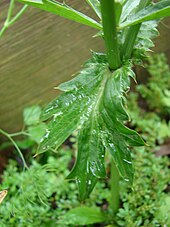Long coriander
| Long coriander | ||||||||||||
|---|---|---|---|---|---|---|---|---|---|---|---|---|

Long coriander ( Eryngium foetidum ) |
||||||||||||
| Systematics | ||||||||||||
|
||||||||||||
| Scientific name | ||||||||||||
| Eryngium foetidum | ||||||||||||
| L. |
The Long coriander ( Eryngium foetidum ), also Mexican coriander , Culantro or Stinkdistel called in Asian grocery stores also Europe Grass , is a flowering plant in the family of umbel bloom plants (Apiaceae). It is native to large areas of the Neotropics . Today Eryngium foetidum is widespread in many tropical to subtropical areas of the world. It owes the specific epithet foetidum and some common names to an intense smell of coriander . The leaves are used as a medicinal herb and spice .
description
Long coriander grows as a biennial herbaceous plant and reaches heights of 8 to 40 cm. A thin taproot with a branched, fibrous root system is formed. The stems are green. The many leaves standing together in a basal rosette are divided into leaf sheath, petiole and leaf blade. The leaf sheath is up to 3 cm long. The petiole is short to rudimentary . The simple, dark green and bare leaf blade is 5 to 25 cm long, 1.2 to 4 cm wide, lanceolate or inverted-lanceolate with a wedge-shaped to downward blade base and a blunt tip. The leaf edge is calloused or notched to finely thorny sawn (hence the English common name "sawtooth coriander" translated directly to "sawtooth coriander"). There is a feathery network nerve. The opposite stem leaves are deeply thorny sawn to divided.
In a branched, three-pronged total inflorescence , many capillary partial inflorescences stand together. The capitate inflorescences stand over short inflorescence shafts. The capillary partial inflorescence emerged from a reduced single umbel . Long coriander is made up of four to seven spread out or curved back, with a length of 1.5 to 3.5 cm and a width of 0.4 to 1 cm, lanceolate, leaf-like, bracts with one to three tips on the edge, directly below the flower heads a thistle-like appearance. The 1.5 to 1.8 cm long and about 0.6 mm wide, lanceolate bracts are lightly dry-skinned at the edge. The pointed calyx teeth are ovate-lanceolate with a length of 0.5 to 1 mm. The white of the light yellow petals are about the same length as the calyx teeth. The upright, about 1.1 mm long style protrudes over the calyx teeth.
The 1.1 to 1.3 mm long, ovoid-spherical fruit is covered with warts.
From April to December both flowers and fruits are present.
The number of chromosomes is 2n = 16.
distribution
Long coriander is native to Central America , where it is usually called culantro or cilantro (which can be misleading, since cilantro is also the common word for coriander green in Anglo-American and Spanish-speaking countries ). In northern Nicaragua it is called both Culantro and Chicoria . Its natural Neotropical range extends from southern Mexico to Bolivia , Peru and Brazil and also includes the Caribbean islands . Today it is also grown in the Asian tropics , especially on the Southeast Asian peninsula .
Systematics
The first publication of Eryngium foetidum done by 1753 Carl Linnaeus in Species Plantarum . Synonyms for Eryngium foetidum L. are: Eryngium antihystericum Rottler , Eryngium foetidum fo. comosum Urb. , Eryngium foetidum fo. nudum H. Wolff , Eryngium molleri Gand.
Smell and Ingredients
All parts of the plant, especially the leaves, give off an intense smell that is reminiscent of coriander leaves . The ingredients responsible for this are, similar to coriander, long-chain aldehydes , especially 2-E-dodecenal and dodecanal. In addition, aromatic aldehydes such as 2,3,6-trimethylbenzaldehyde were found.
use
In folk medicine in the countries of origin, long coriander is used in a variety of ways: It is mainly used against digestive problems , as a sweat and diuretic and as a stimulant .
In the kitchen, long coriander can be used like coriander . The fresh leaves are used to season Caribbean salads and sauces ( salsas ) and to garnish dishes before serving. Long coriander should always be used raw and fresh, as both drying and prolonged cooking cause great loss of taste.
See also
swell
- She Menglan, Mark F. Watson: Eryngium. In: Wu Zheng-yi, Peter H. Raven, Deyuan Hong (Eds.): Flora of China . Volume 14: Apiaceae through Ericaceae . Science Press / Missouri Botanical Garden Press, Beijing / St. Louis 2005, ISBN 1-930723-41-5 , pp. 24 (English). PDF file, Eryngium foetidum (Description and Distribution Sections).
- Christopher Ramcharan: Culantro: A much utilized, little understood herb. In: J. Janick (Ed.): Perspectives on new crops and new uses. Proceedings of the Fourth National Symposium New Crops and New Uses: Biodiversity and Agricultural Sustainability. ASHS Press, Alexandria, VA 1999, ISBN 0-9615027-0-3 , pp. 506-509, online.
Individual evidence
- ↑ Eryngium foetidum at Tropicos.org. In: IPCN Chromosome Reports . Missouri Botanical Garden, St. Louis
- ^ Eryngium in the Germplasm Resources Information Network (GRIN), USDA , ARS , National Genetic Resources Program. National Germplasm Resources Laboratory, Beltsville, Maryland. Retrieved May 27, 2018.
- ↑ Carl von Linné: Species Plantarum. Volume 1, Lars Salvius, Stockholm 1753, p. 232, digitized
- ↑ Eryngium foetidum at Tropicos.org. Missouri Botanical Garden, St. Louis


